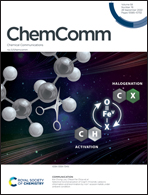A pH-activated fluorescent probe via transformation of azo and hydrazone forms for lysosomal pH imaging†
Abstract
We developed a fluorescent probe Sth-NH by introducing a 6-hydroxypyridone skeleton. The presence of an active proton enables the probe to transform from a deprotonated azo form to a hydrazone form in a strongly acidic environment to realize fluorescence light-up behavior, thus monitoring the lower lysosomal pH of cancer cells and distinguishing them from normal cells.

- This article is part of the themed collection: Chemosensors and Molecular Logic


 Please wait while we load your content...
Please wait while we load your content...